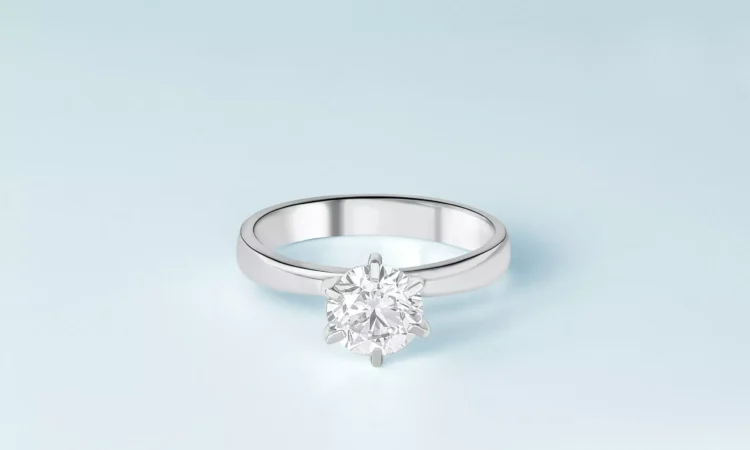
When the time comes to part ways with a treasured piece of jewelry, many people are surprised by how similar platinum and white gold appear. To the untrained eye, the two metals can be nearly indistinguishable, yet their value on the resale market is very different.
This is why understanding how jewelry buyers in Manhattan view these metals is essential for anyone looking to sell. Learning the differences between platinum and white gold and how these distinctions influence pricing, you, as the seller, can expect a smoother and more profitable transaction in New York City.
Differences between Platinum vs. White Gold
At first glance, platinum and white gold can look nearly identical, but their composition and long-term value set them apart. Platinum is a naturally white metal that is typically 90–95% pure when used in jewelry. Its density and weight give it a substantial feel, and it resists tarnish over time.
On the other hand, white gold is created by mixing yellow gold with alloys such as nickel or palladium and then coating it with rhodium for a bright finish. While beautiful, this coating can wear down, which means that it requires maintenance.
These differences matter when you approach platinum buyers. Because platinum is rarer, denser, and purer than white gold, it generally commands a higher resale price. White gold is attractive and durable, but lacks the scarcity factor that makes platinum so valuable. It is crucial to understand this distinction before meeting with potential buyers, ensuring you know exactly what you have and why it matters.
Market Demand: What Jewelry Buyers Are Looking For
In today’s resale market, demand plays a major role in determining what sellers can expect to earn. Platinum is prized for its rarity and long-term durability, so many buyers in New York City view it as a premium investment metal, meaning they are often willing to pay more for well-maintained pieces.
White gold remains popular with jewelry buyers because of its affordability and fashionable appearance. Engagement rings, wedding bands, and designer jewelry frequently use white gold, so there is always a steady demand. However, when it comes to resale, white gold typically brings in less than platinum because it contains a lower percentage of precious metal and often requires re-plating to restore its original shine.
While both metals attract interest, platinum’s prestige and scarcity usually translate into stronger offers from serious buyers.
Selling Platinum in NYC: Why It Pays to Know the Difference
In a city as competitive as New York, sellers benefit from knowing exactly what they own before stepping into a store or arranging an appraisal. Many people are surprised to learn that their jewelry is white gold rather than platinum, which can dramatically affect the offers they receive. Platinum buyers use methods such as hallmark inspection, acid testing, or XRF analysis to verify authenticity and purity, ensuring accurate pricing.
If your goal is to sell platinum, being informed about these processes can give you an advantage. Platinum’s rarity and purity make it more desirable on the resale market, and in NYC, where buyers compete for luxury items, sellers often have the opportunity to secure better deals.
How Sellers Can Benefit: Practical Tips
Knowing the differences between platinum and white gold is only the first step. Turning that knowledge into a successful sale is what truly matters. Here are a few strategies that can help sellers in NYC get the most out of their platinum jewelry:
- Get a Professional Appraisal
Seek out reputable jewelry buyers who specialize in luxury metals. An appraisal from an experienced platinum buyer ensures your piece is accurately evaluated for weight, purity, and market value.
- Compare Multiple Offers
The first offer is rarely the best one. Shopping around among trusted NYC platinum buyers can help you identify who is willing to pay top dollar.
- Check Hallmarks and Markings
Look for engravings like “PLAT” or “PT950” on your jewelry, which indicate platinum purity. White gold will carry markings such as “14K” or “18K.” Confirming this before you sell prevents confusion and strengthens your negotiating position.
- Avoid Pawnshops for Luxury Metals
While they are convenient, pawnshops usually offer only a fraction of an item’s true value. Directly working with jewelry buyers or platinum specialists is often more profitable.
- Consider Timing
Platinum prices can fluctuate with global demand. Staying informed about market trends can help you choose the best moment to sell platinum for maximum return.
Conclusion
Although platinum and white gold may appear nearly identical, jewelry buyers don’t see them the same way. By understanding how platinum buyers evaluate pieces and by approaching the selling process with knowledge and preparation, you can avoid undervaluing your jewelry. Being informed ensures that your transaction is both profitable and stress-free.




